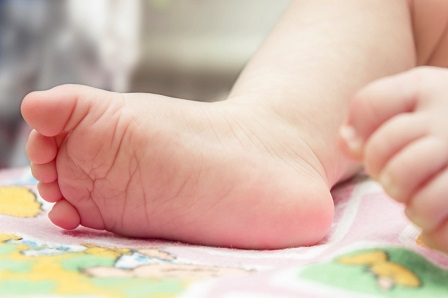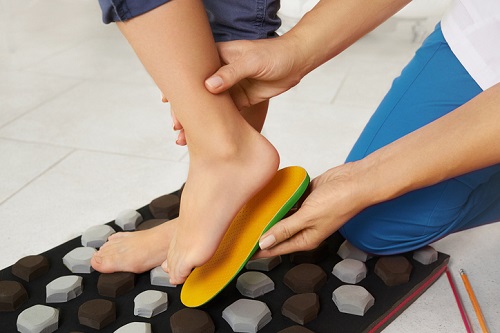While we can definitely help with kids orthotics at our Redlands podiatry clinic, the fact is that flat feet are relatively normal in young children.
And yet when parents bring their child to our podiatry clinic, it is often due to concerns about flat feet and whether orthotics are needed. So I would like to set parents’ minds at ease – it is usually not until your child is five or six that orthotics may be considered.
Most babies appear to have flat feet, and it is only when the child starts to walk that their arch begins to develop. Even after that, the soles of a child’s feet may look flat, but this does not necessarily indicate a problem.

Is it a Case of Flat Foot or Excess Pronation?
The term “flat foot” is a fairly broad term covering a number of foot alignment issues.
True flat foot is a condition where the longitudinal arch of the foot has not yet developed normally; however excess pronation can also make your child’s foot look flat, and cause parents to worry.
“Pronation” describes the natural inward rolling movement of the foot and ankle when they are in motion (eg walking, running). At times it can roll in excessively – and so you might hear it called excess pronation. As the child walks or runs, excess pronation causes:
- the arch of the foot to flatten;
- the fore foot to splay outwards;
- and the ankle to pull upwards.
In a true case of flat foot there is no change in the arch contour (ie it remains flat), regardless of whether the child is standing or sitting.
A pronated foot on the other hand, will seem flat when the child is standing, but there is a fully developed arch profile when the child is seated.
Excess pronation is quite common in children from birth up to about age eight or nine, and is not usually painful. (Important note: if your young child is complaining of aching legs, that they can’t sleep due to leg pain, or have been pleading for you to rub their legs to give them some relief, this merits further investigation for hidden pathologies.)
It happens because bone grows faster than soft tissue, creating a (temporary) muscular imbalance. The child’s foot subsequently pronates to compensate; in some children, it might result in knock knees or bow legs for a time.
There are other factors which may contribute to a change in the arch of the child’s foot – such as limb length discrepancies, or curvature of the lower back.
When are Kids Orthotics Likely to be Needed?
By the age of five or six, your child’s foot bones have positioned themselves, and all they have to do is grow and get bigger.
At this stage if the arch does not appear to be developing, it’s worth visiting your local podiatry clinic to find out if orthotics may be of benefit. Before making a diagnosis we will likely send your child for x-ray and/or ultrasound, to make sure there’s no congenital abnormalities (eg bony fusions, ligament or tendon damage, non-development of particular structures).

In a true case of flat foot, there is no arch – so there is no point in using an orthotic to support an arch that does not exist. In this case, it would simply hurt the patient.
We find that in the majority of cases, children visiting our podiatry clinic are presenting with excess pronation. Treatment for this condition may include advice on footwear choices, exercises, or possibly orthotics.
What sort of Orthotics?
Should your child need insoles or orthotics, there are two types to consider: off the shelf, or customised.
Off the shelf are cheaper, but provide only a certain degree of correction. If there is a marked deformity, a podiatrist will have no choice but to prescribe custom orthotics, because one foot is functioning quite differently to the other.
You can find out more about the different types of orthotics and what is involved, in this post.
If you live in the Redlands, Trevor Lane Podiatry is your local family podiatry centre – so if you have any concerns about whether your child needs orthotics, you can book an appointment now using our secure online booking system.
